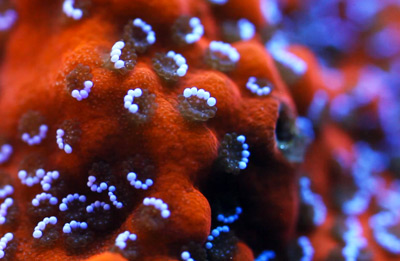One of the big differences in moving from freshwater systems to saltwater systems is a greater emphasis on water chemistry. There is a pretty steep learning curve to get a handle on all the different chemical parameters, and it can be a source of frustration for many aspiring reef hobbyists. In aquariums with an abundance of stony corals, the levels of calcium, alkalinity, and magnesium are important to monitor. This article will focus on magnesium, an important but often overlooked ion in reef chemistry.
What is the role of magnesium in the reef aquarium? First off, it is the third most abundant ion in salt water. The two most abundant ions, for those that are curious, are sodium and chloride. That should come as no surprise, as sodium and chloride make up table salt and give saltwater its characteristic taste.
Magnesium, like most other ions in salt water, is measured in parts per million (ppm). Parts per million is a slightly deceptive sounding unit of measurement. It is a mass ratio rather than an exact count of ions in solution. For example, magnesium represents 1300 ppm while calcium is around 425 ppm. It appears that magnesium is three times more abundant than calcium, but in reality it is much more. Parts per million takes into account the mass of the ions, and it just so happens that calcium is significantly heavier than magnesium. Therefore, magnesium is actually five times more abundant than calcium if you are counting the individual atoms.

Magnesium ions carry two positive charges in solution. Calcium also carries two positive charges in solution, so it should come as no surprise that the two ions behave similarly and are utilized by our coral inhabitants in like ways. When stony corals form their skeletons, magnesium is regularly substituted for calcium.
The interactions of magnesium, calcium, and alkalinity are closely tied to one another. In one of my systems at Tidal Gardens, I just had the hardest time keeping my calcium and alkalinity up. In natural sea water, calcium is about 425 ppm or so. Testing showed that the calcium level in our tank was much lower than that. It was at 325 ppm—in short, 100 ppm off from what it should be. When we start adding calcium to the tank, what often happens is that as the level of calcium goes up, our alkalinity falls. These ions seemingly fight one another as levels change.
When reefers test only for calcium and alkalinity, it can be a very frustrating dance to get both levels to match those of natural salt water. Here is where magnesium comes into play. In the above example, there is a good chance that the magnesium levels were low. Magnesium provides buffering capacity by bonding with carbonate ions. (Remember, carbonate hardness is another term for alkalinity.) Because magnesium binds up carbonate, it allows for more carbonate in the water than if magnesium were not there. An appropriately high magnesium level allows for the addition of calcium without the associated drop in alkalinity.
In summary, we hope this article clears up a little bit the role of magnesium in our water. If you test your water and magnesium is low, there are a few ways to boost it. Most salt mixes these days have a good amount of magnesium already. You could just do more water changes and over time magnesium levels will rise.



